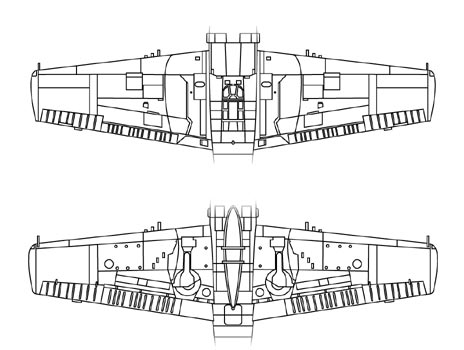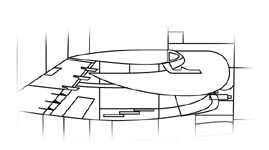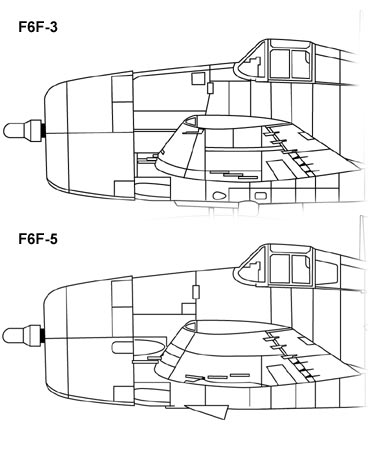F6F Hellcat
Genesis
Quand les Etats-Unis entrèrent en guerre contre le Japon après l'agression de Pearl Harbour le 7 décembre 1942, le chasseur embarqué standard de l'Aéronavale américaine était le F4F Wildcat. Si le F4F disposait d'une meilleure puissance de feu et d'une meilleure protection que les chasseurs japonais comme le Zéro, il manquait de manoeuvrabilité et vitesse ascensionnelle (par contre le Wildcat dépassait le Zéro en piqué). Les Wildcats durent le plus souvent possible utiliser la méthode dite du Yoyo qui consiste en une série de montées et descentes qui permet aux avions américains de compenser un faible rayon de virage. Par contre les Dog fights (combats tournoyant) contre des chasseurs japonais, se révélèrent le plus souvent désastreux. Il était temps pour l'US Navy de disposer d'un nouveau chasseur capable de surclasser les chasseurs japonais, qui garderait les qualités du Wildcat, c'est-à-dire; la vitesse en piqué, la puissance de feu et la robustesse tout en bénéficiant de substantielles améliorations.
When the United States entered in war against Japan after aggression of Pearl Harbour on December 7, 1942, the standard shipborne fighter of American Naval Aviation was the F4F Wildcat. If the F4F had a better firepower and a better protection than the Japanese fighters like the Zero, it missed maneuverability and climbing speed (on the other hand Wildcat exceeded the Zero in dive). Wildcats had as often as possible to use the method known as of the Yoyo which consists of a series of rises and descents which makes it possible the American planes to compensate a weak ray of turn. On the other hand Dog fights (whirling engagements) against Japanese fighters, appeared generally disastrous. It was time for US Navy to have a new hunter able to outclass the Japanese fighters, which would keep qualities of Wildcat, like dive speed, firepower and the robustness while profiting from substantial improvements.
 |
XF6F-1 |
src: Wikipédia |
La firme Grumman, également conceptrice du F4F, avait signé le 30 juin 1941 un contrat pour un successeur du F4F. 4 prototypes avec une motorisation différente furent conçus, le XF6F-1 équipé d'un Wright R-2600-10 Cyclone 14 cylindres en étoile de 1700 CV, le XF6F-2 équipé d'un Wright R-2600-16, le XF6F-3 équipé d'un Pratt and Whitney R-2800-10 Double Wasp et le XF6F-4 d'un Pratt and Whitney R-2800-27. LXF6F-1, effectua son premier vol, le 26 juin 1942, Cependant, les premiers rapports des combats dans le ciel du Pacifique entre les Wildcats et les Zéros, convainquirent les Américains que pour assurer au nouvel avion la domination de l'espace aérien, de privilégier le XF6F-3 dont le moteur Pratt & Whitney R-2800 Double Wasp développant 2 000 CV améliorait de 25% les performances par rapport au XF6F-1. Le nouveau XF6F-3 effectua son premier vol le 3 octobre 1942. Ce fut ce modèle rebaptisé F6F-3 qui équipa en 1943 la première unité de Hellcat opérationnelle, le VF-9, basé sur le porte-avion USS Essex.
The Grumman firm, also conceptrice of the F4F, had signed on June 30, 1941 a contract for a successor of the F4F. 4 prototypes with a different motorization were designed, the XF6F-1 equipped of a Wright R-2600-10 Cyclone 14 star cylinders of 1700 hp, the XF6F-2 equipped of a Wright R-2600-16, the XF6F-3 equipped of a Pratt and Whitney R-2800-10 Doubles Wasp and the XF6F-4 of a Pratt and Whitney R-2800-27. The XF6F-1, accomplished its first flight, on June 26, 1942, However, the first reports of t engagements in the sky of the Pacific between Wildcats and the Zeros, convince the Americans that to ensure the new plane the domination of the airspace, to privilege the XF6F-3 of which the engine Pratt & Whitney R-2800 Double Wasp developing 2.000 hp improved of 25% the performances compared to the XF6F-1. The new XF6F-3 accomplished its first flight on October 3, 1942. It was this model renamed F6F-3 which equipped in 1943 the first operational unit of Hellcat, the VF-9, based on the USS Essex carrier.
Le F6F Hellcat sera produit à 12275 exemplaires en à peine plus de deux ans. Sa conception initiale qui ne nécessita que peu de modifications est l'un des facteurs de cet impressionnante résultat.
The F6F Hellcat will be produced with 12275 specimens in hardly more than two years. Its initial design which did not require that few modifications are one of the factors of this impressive result.
Le F6F était un monoplace à ailes basses contrairement au F4F qui était un monoplace à ailes médianes (implantées au centre du fuselage). L'implantation basse des ailes permet de dégager le champ de vision du pilote et d'implanter un train d'atterrissage plus court. Notons que sur le F4F ce dernier, très étroit, n'était pas monté sous les ailes mais sous le fuselage par action manuelle du pilote. Sur le Hellcat le large train d'atterissage hydraulique pivotait et venait se rétracter vers l'arrière, à plat dans ses logements parallèles au fuselage. Les ailes étaient en deux parties. La partie externe, la plus grande, pouvait pivoter pour venir se placer le long du fuselage, pour gagner de la place dans les hangars ou sur le pont d'envol d'un porte-avion.
The F6F was a single-seater craft with low wings contrary to the F4F which was a single-seater craft with median wings (mounted on the center of the fuselage). Low establishment of the wings makes it possible to release the field of view of the pilot and to establish a shorter landing gear. Let us note that on the F4F this last, very narrow, was not assembled under the wings but under the fuselage by manual action of the pilot. On Hellcat the broad hydraulic landing gear swivelled and came to retract towards back, flat in its housings parallel with the fuselage. The wings were in two parts. The external part, largest, could swivel to come to be placed along the fuselage, to gain place in the hangars or on the take-off deck of a carrier.
|
Top & bottom of wings |
 |
 |
Hellcat sur l'acsenceur d'un porte-avion, prêt
à être monté sur le pont. |
Hellcats dans le hangar d'un porte-avion. |
Hellcat on acsencor of
a carrier, ready to be gone up on the deck. |
Hellcats in the hangar
of a carrier. |
src: Aviation
Models |
src: Aviation
Models |
|
Radar-Pod on right wing of Night
Fighters |
Le F6F était armé de six mitrailleuses Browning M2 de 12.7 mm (.50cal) refroidies par air approvisionnées chacune à 400 coups. Toutes étaient installées dans les parties externes des ailes. Trois points d'attache permettaient de véhiculer une charge offensive d'environ 900 kg maximum. Le point central pouvait également accueillir un réservoir supplémentaire et largable de 568 L. On pouvait également installer sous chaque ailes 3 roquettes de 127 mm HVAR (High Velocity Aircraft Rocket). Notons que sur les versions "chasseur de nuit", un radar (APS-4 au début, puis un APS-6 plus efficace ensuite) était installé dans un pod sur l'aile droite. Notons que la version chasseur de nuit F6F-5N était parfois armés de deux canons de 20 mm ( 0.79cal) Hispano-Suiza HS.404 (225 coups par arme) couplés à deux mitrailleuses de 12.7 mm (.50cal) Browning M2 (400 coups par arme).
The F6F was armed with six machine-guns Browning M2 of 12.7 mm (.50cal) with air cooling supplied each one with 400 rounds. All were installed in the external parts of the wings. Three hardpoints made it possible to convey an offensive load of approximately 900 kg maximum. The central point could also accomodate a releasable additional tank of 568 L. One could also install under each wings 3 rockets of 127 mm HVAR (High Velocity Aircraft Rocket). Let us note that on the versions "night fightert" , a radar (APS-4 at the beginning, then a more effective APS-6 then) was installed in a pod on right wing. Let us note that the version night fighter F6F-5N was sometimes armed with two guns of 20 mm (0.79cal) Hispano-Suiza HS.404 (225 rounds per weapon) coupled to two machine-guns of 12.7 mm (.50cal) Browning M2 (400 rounds per weapon).
|
Comme pour les autres chasseurs américains (et contrairement aux chasseurs japonais), la protection du pilote et des organes vitaux était particulièrement prise en compte sur le F6F. En effet ils étaient protégés par un blindage de 96 kg. La verrière était pare-balles, les réservoirs de carburants étaient auto-obstruants ... Cette attention faisait du F6F un avion très robuste, capable de ramener son pilote à bon port même après avoir supporter un multitudes d'impact... alors que les Zéros avaient tendance à rendre l'âme aux premiers coups.
As for the other American fighters (and contrary with the Japanese fighters), the protection of the pilot and the vital bodies was particularly taken into account on the F6F. Indeed they were protected by a shielding of 96 kg. The canopy was bulletproof, the fuel tanks were auto-obstructing… This attention made of F6F a plane very robust, able to bring back its pilot to good port even after having to support multitudes of impacts… whereas the Zeros tended to fall in flamm since the first blows.
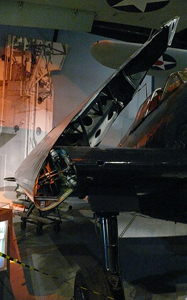 |
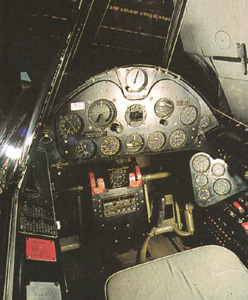 |
Folding Wing |
Cockpit and command pannel |
src: Wikipédia
|
src: Wikipédia |
Le F6F-3 était propulsé par un moteur Pratt & Whitney R-2800 à double étage de compresseurs mécaniques. Le F6F-3 sera équipé d'un Pratt & Whitney R-2800-10W plus puissant, à double étage de compresseurs mécaniques, avec un système d'injection d'eau et d'alcool (permettant de développer jusqu'à 2200 CV), protégé par un capot moteur plus aérodynamique. Le F6F-5 fut également doté d'une verrière offrant une meilleure vision au pilote. A partir du e F6F-5 les petites fenêtres derrière la verrière seront supprimées (sauf sur les premiers). Sur le F6F-5 les éléments de queue furent également renforcés.
The F6F-3 was propelled by an engine Pratt & Whitney R-2800 with double floor of mechanical compressors. The F6F-3 will be equipped of a more powerful Pratt &Whitney R-2800-10W, with double floor of mechanical compressors, with a system of injection of water and alcohol (allowing to develop until 2200 hp), protected by a more aerodynamic engine cowling. The F6F-5 was also equipped with a canopy offering a better vision to the pilot. From E F6F-5 the small windows behind the canopy will be removed (except on the first). On the F6F-5 the elements of tail were also reinforced.
 |
R-2800-21 Double Wasp |
src: Wikipédia
|
Sources:
